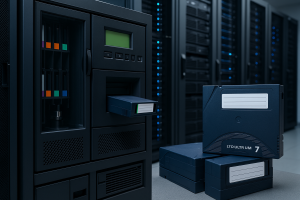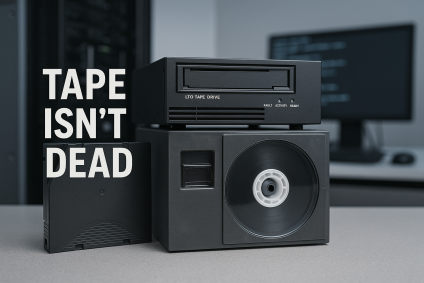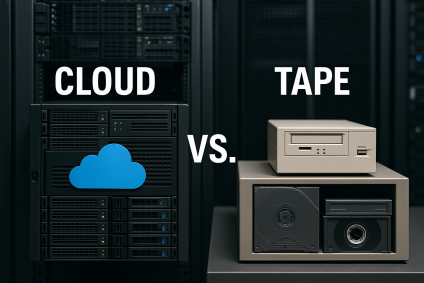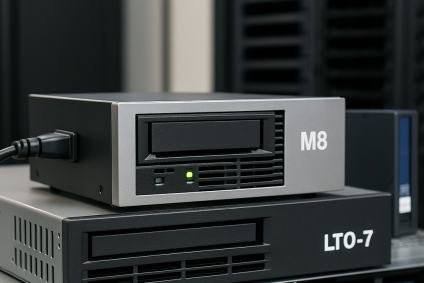The Coming Tape Shortage: Will Your Business Be Left Without Backup?
Why the Tape Shortage Conversation Matters Now
For decades, enterprises have relied on magnetic tape—especially LTO and IBM 3592 cartridges—as the last line of defense in data protection. But in 2025, that safety net is under threat. Tariffs, supply chain disruptions, and skyrocketing demand for storage are creating a perfect storm: a potential tape shortage.
If your organization is still assuming tape will always be cheap and readily available, you may be in for a rude awakening. The question every CIO and IT asset manager must ask: Will my business be left without backup when tape runs dry?
This blog tackles the issue head-on in a question-and-answer format, uncovering the risks, the controversy, and the urgent steps your business should consider—including why tape buyback and resale might be the hidden solution that keeps your backup strategy afloat.
Q1: Is There Really a Tape Shortage Coming, or Just Hype?
The shortage is not just a rumor—it’s being telegraphed by the very companies that dominate the tape industry.
- HP Enterprise (HPE), IBM, and Fujifilm—the three major players—have all raised prices in 2024 and again in 2025, citing raw material costs, tariffs, and strained manufacturing capacity. These price increases have very significant – 30% 40% 50% or more.
- New tariffs on imported IT equipment and specialty materials have further tightened the cost structure.
- Manufacturing is highly centralized and overseas, with only a handful of facilities worldwide capable of producing high-grade tape media. Any disruption—whether geopolitical or environmental—cascades quickly.
So, while you may not see empty shelves today, the writing is on the wall. Enterprises are already reporting delays in bulk orders, especially for higher-generation LTOs (LTO-8 and above) and IBM 3592 cartridges.
📌 Sidebar – Tape Media Alert
- HP, Fuji, and IBM have raised prices by 15–30% in the past 6 months.
- Bulk orders for LTO-8, LTO-9, and IBM 3592 cartridges are already delayed.
- Supply chain experts predict rationing by 2026.
👉 Don’t wait until you’re stuck without backup—start securing inventory now.
Q2: Why Is Demand for Tape Surging When Everyone Talks About the Cloud?
It sounds counterintuitive—cloud-first strategies dominate headlines, yet demand for tape is growing faster than supply. Here’s why:
- Data Explosion: IDC estimates global data creation will more than double by 2026. Hard drives and SSDs are filling up, and enterprises need affordable long-term storage.
- Cold Storage Efficiency: Tape is still the cheapest, most energy-efficient way to archive petabytes of data.
- Ransomware Protection: Tape’s “air gap” makes it a critical part of cyber-resilience.
- Regulatory Compliance: Industries like healthcare, finance, and government are legally bound to store data for 7–30 years. Tape is the only economical choice.
Even the cloud doesn’t eliminate tape—it often creates more demand for it. Cloud providers themselves use massive tape libraries for cold storage tiers.
Q3: How Are Price Increases From HP, Fuji, and IBM Affecting the Market?
Between late 2023 and mid-2025, industry insiders reported tape cartridge prices rising by 30-50%, depending on the generation.
- HP cited increased manufacturing costs and tariffs on raw materials.
- Fujifilm, one of the only producers of magnetic tape coating, noted supply chain bottlenecks.
- IBM, controlling the high-performance 3592 market, increased pricing due to R&D and specialty production limits.
📌 Cost Shock Example
- 2023: LTO-8 cartridge = ~$40 each
- 2024: LTO-8 cartridge = ~$55 each
- 2025: LTO-8 cartridge = ~$65 each effective in September
- Enterprise backups often require thousands of tapes → hundreds of thousands in added costs
👉 Solution: Buyback & resale programs offer 30–40% savings over new tapes. Ask us how.
Q4: Why Can’t Manufacturers Just Ramp Up Production?
Unlike hard drives, which have multiple manufacturers competing worldwide, tape production is a niche, specialized process.
- Only two companies (Fujifilm and Sony until Sony’s exit) have historically made the magnetic coatings.
- Facilities require highly specialized equipment and chemical processes that take years to scale.
- Demand spikes cannot be met quickly—supply is essentially capped.
That means when enterprises suddenly increase orders, the supply chain cannot flex fast enough.
Q5: What Role Do Tariffs and Geopolitics Play?
Tariffs introduced in 2024 and 2025 on imported IT hardware and specialty chemicals hit tape harder than most sectors.
- Much of the coating material and cartridge assembly occurs outside the U.S.
- Import duties add cost layers that vendors simply pass on to customers.
- Geopolitical uncertainty compounds risk.
Result: Not only are tapes getting more expensive, but availability windows are shrinking as shipments face longer customs clearance times.
Q6: How Does This Shortage Collide With Exploding Data Growth?
Consider this paradox:
- By 2026, enterprises worldwide are expected to generate over 200 zettabytes of data.
- Only a fraction will live in active storage. The majority will require archiving.
- Hard drives and SSDs are not suitable for decades-long retention—they fail too soon or cost too much in energy to maintain.
- Tape is the only realistic medium for long-term storage, but production is limited.
That means a classic mismatch: demand is doubling, but supply is stagnant.
📊 Table – LTO Generations vs. Supply Risk
| LTO Generation | Native Capacity | Market Availability | Price Trend 2023–2025 | Risk Level |
|---|---|---|---|---|
| LTO-6 | 2.5 TB | Moderate (secondary market strong) | ↑ 25–30% | High |
| LTO-7 | 6 TB | Good, but tightening | ↑ 20–25% | Medium |
| LTO-8 | 12 TB | Limited, bulk orders delayed | ↑ 30–45% | High |
| LTO-9 | 18 TB | Very limited, premiums rising | ↑ 25–30% | Very High |
| LTO-10 (2025) | 36 TB | Initial rollout only | Premium pricing, scarce | Critical |
Q7: What Happens If Your Business Can’t Secure Tape Media?
The consequences are more severe than many IT teams admit:
- Compliance Failures → Fines and legal exposure.
- Backup Gaps → Risk of unrecoverable data after ransomware.
- Budget Blowouts → Premium pricing erodes budgets.
- Operational Risk → Projects requiring migrations may stall.
Put simply: a tape shortage doesn’t just affect IT procurement—it could cripple business continuity.

Q8: Is Recycling or Destroying Tapes Adding to the Problem?
Here’s the controversial part: the industry’s obsession with shredding tapes for “security” may be making the shortage worse.
- Thousands of perfectly usable LTO and 3592 tapes are shredded every year.
- Many could be securely sanitized using NIST 800-88 compliant degaussing data wipes.
- Instead of reuse, they’re destroyed—reducing the available pool at a time when shortages loom.
📌 Controversial Callout
Are We Shredding Ourselves Into a Shortage?
- Millions of tapes are destroyed annually.
- Secure data wipe is just as compliant and approved as shredding.
- Each destroyed tape is one less cartridge available for reuse.
Q9: How Does Tape Buyback & Resale Solve the Problem?
At We Buy Used IT Equipment, we argue that reuse beats recycling—for both the planet and your balance sheet.0-50
- We purchase used LTO and 3592 tapes from enterprises.
- Every tape undergoes certified data erasure (NIST 800-88).
- The media is resold back into circulation at lower costs than new stock.
📊 Table – New vs. Resale Market Pricing (2025 Averages)
| Tape Type | New Cartridge Cost | Resale Market Cost | Typical Savings |
|---|---|---|---|
| LTO-6 | $40-$50 | $25-$30 | 30–40% |
| LTO-7 | $60-$70 | $40-$50 | 30–40% |
| LTO-8 | $65-$75 | $45-$55 | 25–35% |
| LTO-9 | $90-$100 | $70–$80 | 20–25% |
| IBM 3592-JD | $260–$300 | $160–$180 | 35–40% |
📊 Buyback ROI Example
| Retired Tapes | Estimated Buyback Value | Offset Against New Tape Costs |
|---|---|---|
| 500 LTO-7 | ~$10,000 | Covers ~150 LTO-8 tape purchase |
| 1,000 LTO-8 | ~$25,000 | Covers ~300 LTO-9 tape purchase |
👉 Translation: Your old media might already fund your next-gen upgrade.
Q10: What Should Businesses Do Right Now to Prepare?
- Audit Media Stock: Know your inventory.
- Forecast Needs: Align tape buys with data growth.
- Explore Buyback Programs: Monetize retired media.
- Diversify Suppliers: Avoid reliance on one vendor.
- Educate Leadership: Elevate shortage risk to executives.
Waiting until the shortage fully hits is not a strategy.
Q11: Will the Shortage Actually Get Worse Before It Gets Better?
Most signs point to yes. Even if new capacity is announced, it takes years to scale. Meanwhile, data growth accelerates.
The risk is highest for:
- LTO-8, LTO-9, LTO-10
- IBM 3592-JF and enterprise cartridges
Secondary markets (buyback/resale) may soon become the only reliable source.
Q12: Could This Crisis Spark a Rethink of Tape Strategy?
Yes. The shortage forces tough questions:
- Should enterprises rethink “destroy at all costs” in favor of secure, complaint, and approved reuse?
- Will regulators endorse overwriting instead of shredding?
- Could hybrid storage (tape + HDD + SSD + cloud) buffer shortages?
These debates are happening inside Fortune 500 IT teams right now.
Conclusion: The Clock Is Ticking
The coming tape shortage is not a future possibility—it’s unfolding now.
Businesses that wait may face empty shelves, broken compliance, and ballooning IT costs. Those that act—by auditing, forecasting, and tapping into buyback/resale programs—can stay ahead of the storm.
📌 Take Action Before the Shortage Hits:
- Audit your tape stockpile now.
- Explore tape buyback to unlock value.
- Secure used/refurbished tapes at lower cost before prices spike further.
👉 Contact WeBuyUsedITequipment.net today.
Because when it comes to data protection, the worst time to discover a shortage is after disaster strikes.







